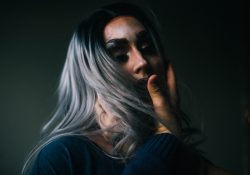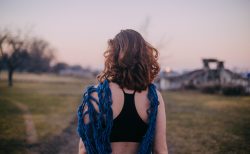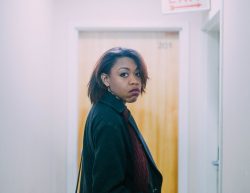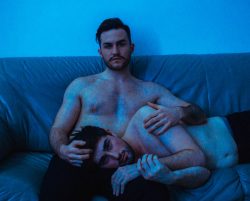On Art and Healing

The Independent's Editor Talks With Ricardo Bouyett on his Innovative Short No Love For Fuckboys
Ricardo Bouyett is a filmmaker, writer, and photographer from Aurora, Illinois. His most recent work, No Love For Fuckboys, is an exploration, at once personal and more broadly social, of the intricacies of navigating dating, friendship, love, and desire after the trauma of sexual assault. The Independent reached out to Ricardo about his provocative 19 minute short.
It is a pleasure to be discussing this film with you, Ricardo. Can you start by talking about your idea for No Love for Fuckboys? What drew you to this project?
My goal was to create a film about finding one’s way through hook-up culture as a rape survivor. I was raped in 2014 and have been creating visual art as a form of therapy ever since. I’ve made several projects that reflect my emotional and mental state throughout different parts of my recovery. With No Love For Fuckboys, I wanted to draw from the moments in my life where I tried to replace the memory of being raped with new and healthier experiences of sexual activity. In the end, this involved random hookups, leading on other guys when I didn’t want to follow through, or even finding myself in abusive short-term relationships.
In the pursuit of wanting to erase a memory, I ended up erasing parts of myself. I saw myself as a monster, incapable of being loved, for the longest time, and I got to a point where I accepted this as a truth about me. But I was also thinking a lot about other people who haven’t been in my position, who don’t know how to date a rape survivor. I was wondering too if gay men truly understand the meaning of full consent or of how to talk about it. No Love For Fuckboys was born out of this thinking.
Issues of memory—of needing to erase or cope with a violent or painful past—are central to healing from trauma. Of course, trauma is a clinical and psychological injury, but it is also an interpretive mode. Can you say more about how you incorporate all that we know about trauma, its impacts on memory, critical thinking, knowability, and speakability, into your work?

I have incorporated my experiences with PTSD into my work. In its 7 separate chapters and poetic verse, No Love for Fuckboys replicates the fragmented memory and language of trauma. The chapters reveal different moments of my recovery and what I’ve learned in those moments.
In the “Love Without Consent” scene, I explore issues of consent between two girlfriends where one had previously endured sexual abuse and the other never had. Jessica’s character doesn’t quite understand why touching her partner, Jude, would set her off unexpectedly. Through much of that scene, Jude’s character doesn’t speak up about how it bothers her because of overwhelming guilt of letting down her partner. That can be nearly as unbearable as the physical discomfort of being touched when you don’t want to be touched.
Can you elaborate on how traumatic modes work into other scenes?
The “I See Myself In Other Lovers” scene presents the idea of climbing outside of yourself to survive yourself. This is sort of a dissociation where you stop being yourself and put on a persona. Kristin and Michael have just wrapped up exchanging sex stories and here’s Nailah wishing so badly to be wanted the same way Michael was, even though that ended badly. She’s dancing by herself in an alley by the trash and all of a sudden her delusion collides with Kristin and they become the same person bending backwards underneath the colored party lights. “Tell me I’m pretty, decadent, monstrous.” This may be my favorite line of the poem because it’s playing on that needy tendency that can coexist with the thrill of exclaiming who and what we are: we are all attractive and also capable of being destructive.
Nailah embodies this simply through her recreational drug use and solo dance party. She isn’t scared to be lonely; she in fact celebrates her isolation in this moment. This resonates strongly with me because when I moved back to Chicago I went out dancing over in the Boystown neighborhood on the north side of Chicago with a few friends to celebrate. I was in the middle of the dance floor at Roscoe’s (popular bar in Boystown) drenched in sweat and dancing. I took a moment and looked around and saw everyone had someone they were with and I was alone, and for the first time I felt powerful in my loneliness. That to me was a huge stepping stone in my recovery because I always thought I needed to find someone else to love me in order for me to stop feeling like I was garbage, but in that moment I finally knew what loving myself meant. So, “tell me I’m pretty, decadent, monstrous,” came directly from that night because that was when I started being self-aware, enough to know my strengths, my weaknesses, and to never stop loving myself.

In your mind, how do the disparate scenes come together?
Altogether, they illustrate how memories and emotions—some normal and some traumatic— can be isolated and compartmentalized in the traumatic mind. So much of the work of feeling “normal” again is finding ways to experience all memory, connected and fully, as one cohesive narrative. No Love For Fuckboys is paradigmatic of a healing (not healed) mind.
Did you draw from other artists who work with traumatic experience or memory, either in visual or narrative modes?
I’m really enamored with the narrative modes found in long-form music videos, specifically those that incorporate brief narrative intros that transition into a musical performance as opposed to a traditional dialogue performance. I channel this in the seven chapters of the film. Each section features its own song.
The scene where Michael and Chase hook up was inspired by the “What Kind of Man” section of Florence Welch’s film The Odyssey, which she collaborated on with Vincent Hayock. It’s a dream of mine to be able to make a visual album as powerfully impactful as Beyonce’s “Lemonade.” I took a lot of inspiration from Beyonce’s performance of Warsan Shire’s poetry when directing Chase Ingrande, who performed the poetry for No Love For Fuckboys.
I am glad you brought up music, which is used quite powerfully in this film. At times the music really does take over—it is the means by which the story is told. Can you elaborate on your selections?
I partnered with Steve Matthew Carter on the score for the film; we wanted the music to reflect the emotional arc of the poetry and compliment the heavy visual effects of the film. During post-production, I emailed Steve my notes and musical inspiration stemming from the musical score in Clayton Vomero’s short film Gang, to my favorite musical artist Florence and The Machine’s song “St Jude.”

The opening number was inspired by the songs of James Brown, notably “Try Me.” I wanted the opening song to be romantic in nature and also to sound subtly needy to contrast CJ dancing around the room. Playing on the title of the film, Steve kept singing “Won’t you love me, because I need you. Yes I do. Love me” over and over, interjecting that desperation. The song for “I See Myself In Other Lovers” combines a jazzy trumpet and a startling electronic mix. Inspired by Nina Simone, Beyonce, and FKA Twigs, the track makes for a compelling “calm before the storm.”
My favorite song that Steve composed for the film was for the “Desire Scares Like Fire” sequence. It’s full, warm, relaxing, and makes you feel triumphant. There is a real contrast here between the song and what is happening in the scene: Chase’s drag character finds herself in Michal’s grip. I really enjoy using dissonant sound and visuals; it makes you feel two different experiences at once. And I would like to be honest and say that this is how I experience sex now after having been raped. When I was being raped, my body responded to the physical pleasure, although I was horrified and panicked. There was a mixture of pain, pleasure, and anger that is hard to explain. And it continues even now in my current physical encounters. This disassociation— between one’s body and one’s psyche—is what I’m trying to illustrate with my jarring sound and more shocking visuals.
The film’s final song, “Four in the Morning,” is by Michael LaValle. You see Jude finally stand up for herself against Jessica, Nailah climbs her way to the rooftop of her building, and the house party lights up with life and movement. Four a.m. is a constant theme throughout the short; it has personal resonance for me as it is the time I routinely wake from nightmares. I use it, here, as a metaphor for the way the characters are linked, always on someone’s mind.
You mentioned visuals before, which are really stunning and also fairly experimental. Can you talk about stylistic choices more generally in this film? What were you trying to achieve?
Thank you! Throughout my recovery, a lot of my mind has been in this colorful yet muted head-space. No matter how often I participated in social events, I would find myself caught in a fog and my body would be spiraling around looking for something to ground reality. This feeling of being mentally distant but physically present is what I wanted to translate through the film’s various effects. The entire short takes place in the same apartment, my apartment, with the exception of the house party scene. Only two characters throughout the entire short are ever outside (Jacqui and Nailah), so the space of the film is tight and confined in contrast to the emotional distances or impasses that the characters struggle to close.

Physical movement helped me explore not only the tension between guilt and desire but also the importance of reclaiming agency. The film begins with CJ dancing and ruling the house party. She’s this embodiment of control, sensuality, and self-love. We see her take a sip of her drink and she begins to dance by herself while everyone else just sits there, unbothered. The thought I had when directing this scene was that I wanted CJ’s character to tell the party guests with her movement that she wants to dance with them but is as content dancing by herself and having everyone watch. The straightforwardness in her dance felt revolutionary; it isn’t hyper-sexual rather an expression of a woman taking control of the scene. CJ, a bit bored, simply tries to liven things up and enjoy her time.
You make interesting choices with dialogue, voice-over, and poetry. Can you talk about how you incorporate language in this piece?
I wrote the poetry for the film, which is poignant but also broad. I wanted the language to feel meaningful to rape survivors but also relatable to those who have not experienced this trauma. After all, issues of consent and abuse affect everyone and are varied in circumstance. The film’s voice-over is a performance of this poem in seven chapters; it is a meditation on consent that also accounts for the tension between not wanting to be a sexual object while still wishing to experience human sexual freedom.
There is dialogue in the film too. I wanted the conversation between Kristin and Michael to feel like two friends just talking about past hookups. Their friendship is a form of intimacy as necessary as a sexual or romantic relationship. In presenting them hanging out, sharing a down-to-earth moment, I provide some relief from the heavier emotional terrain of the film.
You get very emotional performances from your actors. What is your approach to working with cast and crew?
Often, I’ll have a one-on-one with my actors, and I’ll walk them through the scene and why I wrote it. I ask a lot of questions, do what I can to create a comfortable atmosphere on set, and then I give them complete creative freedom. I want them to draw from their interpretations and experiences too. I’m always learning something new from my actors. I am not afraid to let them take control of their roles and take the project away from me a bit. It’s this collaboration that gives the project its diversity and also its magic.
The biggest challenge came in directing the “Love Without Consent” scene. I had never directed two women being intimate with each other on-screen before, let alone a scene where one takes advantage of another. I wanted to make sure everyone was comfortable with what I was asking of them; I did my best to ensure everyone felt safe. It took time, lots of rehearsal, but eventually, I felt comfortable that they were confident in themselves and in their performances.
The title is obviously provocative. Can you tell us how you settled on this choice? How does it connect to the ways you want viewers to feel about this film?

In 2016, I made a body of work called “Oh, Bouy” which is a collection of fine art photography, poetry, and short films that explore my recovery. One poem “No Love for Fuckboys” interrogated the notion of promiscuity, especially in light of surviving a sexual assault. The idea behind the title isn’t to say that promiscuous men don’t deserve love but to suggest that love isn’t the goal of someone who’s perpetuating a cycle of self-destructive behavior. At my premiere party, members of the audience admitted to expecting the film to a kind of “diss” on “fuckboys.” They were surprised to find themselves immersed in the emotional journey of someone’s recovery. This divide, between what’s expected and what’s given, is present in art and in relationships too, and that was also behind my reasoning in choosing this title.
I am struck by the way queerness is everywhere in this film and yet also not the subject of the film. Do you know what I mean? What messages about sexuality were you after?
Yes, I get the question completely. As for message, I’m portraying queer characters going through the exact same things heterosexual characters go through without making a big deal of the fact that they’re queer—at the end of the day, they’re just people. Human sexuality is complex and does not exist in a binary but in a spectrum. I’m focused on making work that’s about the human psyche, human emotions, human relationships lived by people that aren’t represented in media, film, or art. In general, I am moved to explore deep social challenges. Rape culture (the subject of this film) is systemic; it exists and is sustained by everyone whether straight, queer, gay, lesbian, bisexual, trans, etc. The message is that your sexual identity doesn’t pardon you from being held accountable for how you treat others.
How have you developed an audience for No Love for Fuckboys?
I have promoted this film in a variety of ways, on the festival circuit and in more intimate settings. The film has also attracted a following on social media. I’ve done several Q&A’s at private screenings; I enjoy this interactive atmosphere and a chance to really discuss the work. Recently, the film screened at an event hosted by the artist collective Mind Pirates. They showcased a few of my short films that deal with surviving sexual trauma. I’m grateful for the all these opportunities to present my work. I live for creating stories and am always open to moments where I can learn and improve my craft.
Fantastic! Can you say a bit more about the film’s festival run?
Sure! No Love For Fuckboys featured at Short To The Point International Film Festival where it won “Best Experimental Short” and at the Bucharest Shortcut Cinefest, where it was nominated as a finalist for “Best Editing.” I am really humbled by these honors. My main goal in sending out the film to festivals and publications is to share a body of work from a new artist and a less traditional voice. Sadly, rejection is common, but I learn from this. It allows me to pay better attention to where the audience exists for these films.
What are your plans moving forward, for this film or for other projects?
Moving forward, I want to take what I’ve learned in producing this short, both from an artistic and a business standpoint, and apply it to creating my first feature film. In the meantime, I’ll be finishing up production of my next short film, Paloma, which is more plot-driven than No Love For Fuckboys. As I’ve said before, I live to create stories powerful enough to help others recover from their own mental and emotional injuries.
Regions: Chicago
